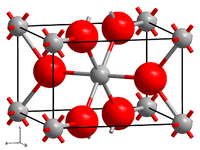Rhenium (IV) oxide
| Crystal structure | |||||||||||||||||||
|---|---|---|---|---|---|---|---|---|---|---|---|---|---|---|---|---|---|---|---|

|
|||||||||||||||||||
| __ Re 4+ __ O 2− | |||||||||||||||||||
| General | |||||||||||||||||||
| Surname | Rhenium (IV) oxide | ||||||||||||||||||
| other names |
Rhenium dioxide |
||||||||||||||||||
| Ratio formula | ReO 2 | ||||||||||||||||||
| Brief description |
gray-black solid |
||||||||||||||||||
| External identifiers / databases | |||||||||||||||||||
|
|||||||||||||||||||
| properties | |||||||||||||||||||
| Molar mass | 218.21 g mol −1 | ||||||||||||||||||
| Physical state |
firmly |
||||||||||||||||||
| density |
11.4 g cm −3 |
||||||||||||||||||
| Melting point |
1000 ° C (decomposition) |
||||||||||||||||||
| solubility |
almost insoluble in water |
||||||||||||||||||
| safety instructions | |||||||||||||||||||
|
|||||||||||||||||||
| As far as possible and customary, SI units are used. Unless otherwise noted, the data given apply to standard conditions . | |||||||||||||||||||
Rhenium (IV) oxide is an inorganic chemical compound of rhenium from the group of oxides .
Extraction and presentation
Rhenium (IV) oxide can be obtained by reacting rhenium with rhenium (VI) oxide .
It is also possible to display it by heating ammonium perrhenate in a stream of dry nitrogen , argon or in a vacuum , with the monoclinic or orthorhombic modification occurring depending on the temperature .
By reducing rhenate (VII) solutions, it is obtained as an oxide hydrate, which can be easily dehydrated.
Single crystals of the β-oxide can be produced using a CVT (Chemical Vapor Transport) method . For this purpose, rhenium (VI) oxide is first reacted with elemental rhenium with the addition of a few mg of iodine in a melted and evacuated ampoule at 500 ° C to form the polycrystalline oxide. The gray-black oxide is then melted into a new ampoule with about 1% iodine and this is placed in a 2-zone oven so that half of the ampoule is in one of the zones. While half of the ampoule is heated to 850 ° C, the other half is held at 825 ° C. After a reaction time of 3 days (with 0.5 g of oxide initially used), the ampoule is allowed to cool and, after opening, black single crystals of the target compound about 2 to 3 mm in size are obtained, which are often twinned . Should the surface show red discoloration due to oxidation processes during cooling, it can be removed by rinsing with cold, diluted nitric acid
properties
Rhenium (IV) oxide is a gray-black solid. The permanent α-modification that occurs below 300 ° C is irreversibly converted into the β-modification at temperatures above 300 ° C. The α-modification has a monoclinic crystal structure (a = 558 pm, b = 481 pm, c = 558 pm, β = 120.9 °) of the molybdenum (IV) oxide or tungsten (IV) oxide type. The β-modification has an orthorhombic crystal structure with the space group Pbcn (space group no. 60) and the lattice parameters a = 480.9 pm, b = 564.3 pm and c = 460.1 pm. Both modifications show metallic conductivity. They are insoluble in water, bases, non-oxidizing acids. They are soluble in hydrohalic acids ; they react with hydrogen peroxide and nitric acid to form perrhenic acid . With oxygen , a conversion to rhenium (VII) oxide takes place at an elevated temperature and a disproportionation to rhenium and rhenium (VII) oxide takes place in a vacuum at temperatures above 850 ° C. With metal (II) oxides it forms double oxides Me (II) ReO 3 with a perovskite structure. There is also a hydrate which is in the form of a brown-black X-ray amorphous powder. It loses water at 500 ° C in a vacuum and changes to the anhydrous form.
Individual evidence
- ↑ a b c d e f g Georg Brauer (Ed.) U. a .: Handbook of Preparative Inorganic Chemistry. 3rd, revised edition. Volume III, Ferdinand Enke, Stuttgart 1981, ISBN 3-432-87823-0 , p. 1617.
- ↑ a b c data sheet Rhenium (IV) oxide, 99.7% trace metals basis from Sigma-Aldrich , accessed on July 28, 2013 ( PDF ).
- ^ Jean d'Ans, Ellen Lax, Roger Blachnik: Pocket book for chemists and physicists . Springer DE, 1998, ISBN 3-642-58842-5 , pp. 694 ( limited preview in Google Book search).
- ^ A b Erwin Riedel: Inorganic Chemistry . Walter de Gruyter, 2004, ISBN 3-11-018168-1 , p. 811 ( limited preview in Google Book search).
- ↑ DB Rogers et al .: Single crystals of transition-metal dioxides - C. Tungsten dioxide and β-rhenium dioxide . In: FA Cotton (Ed.): Inorganic Syntheses . tape 13 . McGraw-Hill Book Company, Inc., 1972, ISBN 07-013208-9 ( defective ) , p. 135-145 (English).


